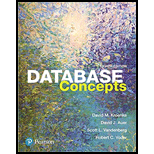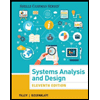
DATABASE CONCEPTS+MYITLAB
18th Edition
ISBN: 9780134821245
Author: KROENKE
Publisher: PEARSON C
expand_more
expand_more
format_list_bulleted
Concept explainers
Expert Solution & Answer
Chapter 1, Problem 1.1RQ
Explanation of Solution
Historic development of internet:
Internet is nothing, but the global
- It is used to connect all the LANs (Local Area Network) in which PCs (Personal Computer) were networked using Ethernet networking technology.
- Internet was widely used when World Wide Web (WWW) became easily accessible in 1993 for which a computer software application called Web browser was used to browse websites.
- In the initial stage of development of internet, ARPANET used NCP (Network control protocol) for the transmission of data.
- In 1983, ARPANET changed its networking protocols from NCP to more powerful and flexible transport layer protocol named TCP/IP (Transmission Control Protocol/Internet Protocol).
- Today ARPANET can be called as the predecessor to modern internet.
Historic development of smartphone:
- Alexander Graham Bell first invented telephone in 1878 which evolved as cell phone in 1980s by Motorola which were very expensive and not that user friendly and became the reason for developing the Smartphone’s.
- The intention behind mobile phone or cell phone development was for commercial use in 1970s which went through lot of infrastructural development and evolved into Smartphone.
- First time the Smartphone was brought into market in 1993 by IBM and BellSouth.
- In 2007 Apple introduced iPhone. Then, Smartphone emerged as android-based Smartphone in 2008 after Google created android
operating system . - Now-a-days, Smartphone deals with many things as GPS capability, document editing, internet access, and many more.
Want to see more full solutions like this?
Subscribe now to access step-by-step solutions to millions of textbook problems written by subject matter experts!
Students have asked these similar questions
Please solve and answer the questions correctly please. Thank you!!
Considering the TM example of binary sum ( see attached)do the step-by-step of execution for the binary numbers 1101 and 11.
Feel free to use the Formal Language Editor Tool to execute it;
Write it down the current state of the tape (including the head position) and indicate the current state of the TM at each step.
I need help on inculding additonal code where I can can do the opposite code of MatLab, where the function of t that I enter becomes the result of F(t), in other words, turning the time-domain f(t) into the frequency-domain function F(s):
Chapter 1 Solutions
DATABASE CONCEPTS+MYITLAB
Ch. 1 - Prob. 1.1RQCh. 1 - Prob. 1.2RQCh. 1 - Prob. 1.3RQCh. 1 - Why is the study of database technology important?Ch. 1 - Prob. 1.5RQCh. 1 - Describe the purpose of a database.Ch. 1 - Prob. 1.7RQCh. 1 - Prob. 1.8RQCh. 1 - Prob. 1.9RQCh. 1 - Prob. 1.10RQ
Ch. 1 - Break the list in Figure 1-34 into two tables,...Ch. 1 - Show how the tables you created for question 1.11...Ch. 1 - Prob. 1.13RQCh. 1 - Prob. 1.14RQCh. 1 - Break the list in Figure 1-35 into tables, each...Ch. 1 - Describe in your own words and illustrate with...Ch. 1 - Prob. 1.18RQCh. 1 - Define the term database.Ch. 1 - Prob. 1.20RQCh. 1 - List the components of a database.Ch. 1 - Prob. 1.22RQCh. 1 - Prob. 1.23RQCh. 1 - Prob. 1.24RQCh. 1 - What is the purpose of a DBMS?Ch. 1 - List the specific functions of a DBMS.Ch. 1 - Define the term referential integrity constraint....Ch. 1 - Prob. 1.28RQCh. 1 - List the functions of a database application.Ch. 1 - Prob. 1.30RQCh. 1 - Prob. 1.31RQCh. 1 - Prob. 1.32RQCh. 1 - Prob. 1.33RQCh. 1 - Prob. 1.34RQCh. 1 - Prob. 1.35RQCh. 1 - Prob. 1.36RQCh. 1 - Prob. 1.37ECh. 1 - Prob. 1.38ECh. 1 - Prob. 1.39E
Knowledge Booster
Learn more about
Need a deep-dive on the concept behind this application? Look no further. Learn more about this topic, computer-science and related others by exploring similar questions and additional content below.Similar questions
- I need help with the TM computation step-by-step execution for the binary numbers 1101 and 11. Formal Language Editor Tool can be used to execute it; Write it down the current state of the tape (including the head position) and indicate the current state of the TM at each step;arrow_forwardWriting an introduction manual for software designarrow_forward"Do not use AI tools. Solve the problem by hand on paper only and upload a photo of your handwritten solution."arrow_forward
- "Do not use AI tools. Solve the problem by hand on paper only and upload a photo of your handwritten solution."arrow_forward"Do not use AI tools. Solve the problem by hand on paper only and upload a photo of your handwritten solution."arrow_forward"Do not use AI tools. Solve the problem by hand on paper only and upload a photo of your handwritten solution."arrow_forward
- Solve this "Do not use AI tools. Solve the problem by hand on paper only and upload a photo of your handwritten solution."arrow_forward"Do not use AI tools. Solve the problem by hand on paper only and upload a photo of your handwritten solution."arrow_forward"Do not use AI tools. Solve the problem by hand on paper only and upload a photo of your handwritten solution."arrow_forward
arrow_back_ios
SEE MORE QUESTIONS
arrow_forward_ios
Recommended textbooks for you
 Principles of Information Systems (MindTap Course...Computer ScienceISBN:9781305971776Author:Ralph Stair, George ReynoldsPublisher:Cengage Learning
Principles of Information Systems (MindTap Course...Computer ScienceISBN:9781305971776Author:Ralph Stair, George ReynoldsPublisher:Cengage Learning Systems Analysis and Design (Shelly Cashman Serie...Computer ScienceISBN:9781305494602Author:Scott Tilley, Harry J. RosenblattPublisher:Cengage Learning
Systems Analysis and Design (Shelly Cashman Serie...Computer ScienceISBN:9781305494602Author:Scott Tilley, Harry J. RosenblattPublisher:Cengage Learning Fundamentals of Information SystemsComputer ScienceISBN:9781305082168Author:Ralph Stair, George ReynoldsPublisher:Cengage Learning
Fundamentals of Information SystemsComputer ScienceISBN:9781305082168Author:Ralph Stair, George ReynoldsPublisher:Cengage Learning Systems ArchitectureComputer ScienceISBN:9781305080195Author:Stephen D. BurdPublisher:Cengage Learning
Systems ArchitectureComputer ScienceISBN:9781305080195Author:Stephen D. BurdPublisher:Cengage Learning Fundamentals of Information SystemsComputer ScienceISBN:9781337097536Author:Ralph Stair, George ReynoldsPublisher:Cengage Learning
Fundamentals of Information SystemsComputer ScienceISBN:9781337097536Author:Ralph Stair, George ReynoldsPublisher:Cengage Learning

Principles of Information Systems (MindTap Course...
Computer Science
ISBN:9781305971776
Author:Ralph Stair, George Reynolds
Publisher:Cengage Learning


Systems Analysis and Design (Shelly Cashman Serie...
Computer Science
ISBN:9781305494602
Author:Scott Tilley, Harry J. Rosenblatt
Publisher:Cengage Learning

Fundamentals of Information Systems
Computer Science
ISBN:9781305082168
Author:Ralph Stair, George Reynolds
Publisher:Cengage Learning

Systems Architecture
Computer Science
ISBN:9781305080195
Author:Stephen D. Burd
Publisher:Cengage Learning

Fundamentals of Information Systems
Computer Science
ISBN:9781337097536
Author:Ralph Stair, George Reynolds
Publisher:Cengage Learning